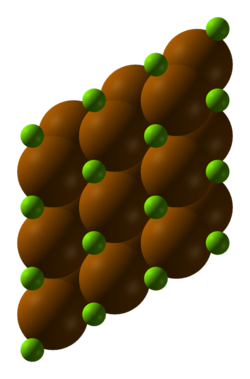Polonide
Topic: Chemistry
 From HandWiki - Reading time: 4 min
From HandWiki - Reading time: 4 min

A polonide is a chemical compound of the radioactive element polonium with any element less electronegative than polonium.[1] Polonides are usually prepared by a direct reaction between the elements at temperatures of around 300–400 °C.[2][3] They are amongst the most chemically stable compounds of polonium,[4] and can be divided into two broad groups:
- ionic polonides, which appear to contain the Po2− anion;
- intermetallic polonides, in which the bonding is more complex.
Some polonides are intermediate between these two cases and others are non-stoichiometric compounds. Alloys containing polonium are also classed as polonides. As polonium is immediately below tellurium in the periodic table, there are many chemical and structural similarities between polonides and tellurides.
Naturally occurring polonides
Lead polonide (PbPo) occurs naturally, as lead is produced in the alpha decay of polonium.[5]
Ionic polonides
The polonides of the most electropositive metals show classic ionic structural types, and can be considered to contain the Po2− anion.
| Formula | Structure | Lattice parameter |
Ref. |
|---|---|---|---|
| Na2Po | anti-Fluorite | 747.3(4) pm | [4][2] |
| CaPo | halite (NaCl) | 651.0(4) pm | [4][2] |
| BaPo | halite (NaCl) | 711.9 pm | [4][3] |
With smaller cations, the structural types suggest greater polarization of the polonide ion, or greater covalency in the bonding. Magnesium polonide is unusual as it is not isostructural with magnesium telluride:[3] MgTe has a wurtzite structure,[6] although a nickeline-type phase has also been reported.[7]
| Formula | Structure | Lattice parameter |
Ref. |
|---|---|---|---|
| MgPo | nickeline (NiAs) | a = 434.5 pm c = 707.7 pm |
[4][3] |
| BePo | sphalerite (ZnS) | 582.7 pm | [4][2] |
| CdPo | sphalerite (ZnS) | 666.5 pm | [4][3] |
| ZnPo | sphalerite (ZnS) | 628(2) pm | [2] |
The effective radius of the polonide ion (Po2−) can be calculated from the Shannon (1976) ionic radii of the cations:[8] 216 pm for 4-coordination, 223 pm for 6-coordination, 225 pm for 8-coordination. The effect of the lanthanide contraction is clear, in that the 6-coordinate telluride ion (Te2−) has an ionic radius of 221 pm.[8]
The lanthanides also form sesquipolonides of formula Ln2Po3, which can be considered to be ionic compounds.[9]
Intermetallic polonides
The lanthanides form very stable polonides of formula LnPo with the halite (NaCl) structure. Many of them seem to involve trivalent lanthanides (though Sm, Eu, and Yb with more stable +2 oxidation states are exceptions), making them resemble electrides. They are isostructural to the lanthanide sulfides, selenides, and tellurides.[10] These compounds are stable to at least 1600 °C (the melting point of thulium polonide, TmPo, is 2200 °C), in contrast to the ionic polonides (including the lanthanide sesquipolonides Ln2Po3), which decompose at around 600 °C.[4][9] The thermal stability and non-volatility of these compounds (polonium metal boils at 962 °C) is important for their use in polonium-based heat sources.[9]
Mercury and lead also form 1:1 polonides. Platinum forms a compound formulated as PtPo2, while nickel forms a continuous series of phases NiPox (x = 1–2). Gold also forms solid solutions with polonium over a wide range of compositions,[4][2][11] while bismuth and polonium are completely miscible.[3] No reaction is observed between polonium and aluminium, carbon, iron, molybdenum, tantalum or tungsten.[3]
References
- ↑ International Union of Pure and Applied Chemistry (2005). Nomenclature of Inorganic Chemistry (IUPAC Recommendations 2005). Cambridge (UK): RSC–IUPAC. ISBN:0-85404-438-8. pp. 69, 260. Electronic version..
- ↑ 2.0 2.1 2.2 2.3 2.4 2.5 Moyer, Harvey V. (1956), "Chemical Properties of Polonium", in Moyer, Harvey V., Polonium, Oak Ridge, Tenn.: United States Atomic Energy Commission, pp. 33–96, doi:10.2172/4367751, TID-5221, http://www.osti.gov/bridge/servlets/purl/4367751-nEJIbm/.
- ↑ 3.0 3.1 3.2 3.3 3.4 3.5 3.6 Bagnall, K. W. (1962), "The Chemistry of Polonium", Adv. Inorg. Chem. Radiochem., Advances in Inorganic Chemistry and Radiochemistry 4: 197–229, doi:10.1016/S0065-2792(08)60268-X, ISBN 978-0-12-023604-6, https://books.google.com/books?id=8qePsa3V8GQC&pg=PA197.
- ↑ 4.0 4.1 4.2 4.3 4.4 4.5 4.6 4.7 4.8 Greenwood, Norman N.; Earnshaw, Alan (1984). Chemistry of the Elements. Oxford: Pergamon Press. p. 899. ISBN 978-0-08-022057-4. https://books.google.com/books?id=OezvAAAAMAAJ&q=0-08-022057-6&dq=0-08-022057-6&source=bl&ots=m4tIRxdwSk&sig=XQTTjw5EN9n5z62JB3d0vaUEn0Y&hl=en&sa=X&ei=UoAWUN7-EM6ziQfyxIDoCQ&ved=0CD8Q6AEwBA..
- ↑ Weigel, F. (1959). "Chemie des Poloniums". Angewandte Chemie 71 (9): 289–316. doi:10.1002/ange.19590710902. Bibcode: 1959AngCh..71..289W.
- ↑ Zachariasen, W. (1927), "Über die Kristallstruktur des Magnesiumtellurids", Z. Phys. Chem. 128: 417–20, doi:10.1515/zpch-1927-12830.
- ↑ Rached, D.; Rabah, M.; Khenata, R.; Benkhettou, N.; Baltache, H.; Maachou, M.; Ameri, M. (2006), "High pressure study of structural and electronic properties of magnesium telluride", J. Phys. Chem. Solids 67 (8): 1668–73, doi:10.1016/j.jpcs.2006.02.017, Bibcode: 2006JPCS...67.1668R.
- ↑ 8.0 8.1 Shannon, R. D. (1976), "Revised Effective Ionic Radii and Systematic Studies of Interatomic Distances in Halides and Chalcogenides", Acta Crystallogr. A 32 (5): 751–67, doi:10.1107/S0567739476001551, Bibcode: 1976AcCrA..32..751S.
- ↑ 9.0 9.1 9.2 Heat Sources for Thermoelectric Generators, Miamisburg, Ohio: Monsanto Research Corporation Mound Laboratory, 1963, https://www.osti.gov/opennet/servlets/purl/16137309-oYiakP/16137309.pdf.
- ↑ Kershner, C. J.; DeSando, R. J.; Heidelberg, R. F.; Steinmeyer, R. H. (1966), "Rare earth polonides", J. Inorg. Nucl. Chem. 28 (8): 1581–88, doi:10.1016/0022-1902(66)80054-4. Kershner, C. J.; Desando, R. J. (1970), "Promethium polonide synthesis and characterization", J. Inorg. Nucl. Chem. 32 (9): 2911–18, doi:10.1016/0022-1902(70)80355-4.
- ↑ Witteman, W. G.; Giorgi, A. L.; Vier, D. T. (1960), "The Preparation and Identification of some Intermetallic Compounds of Polonium", J. Phys. Chem. 64 (4): 434–40, doi:10.1021/j100833a014.
 |
 KSF
KSF